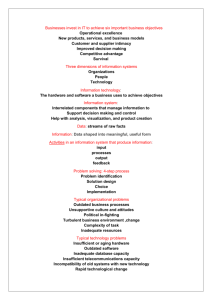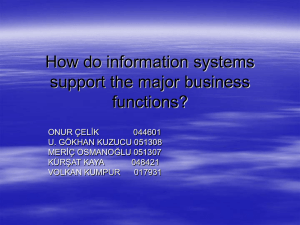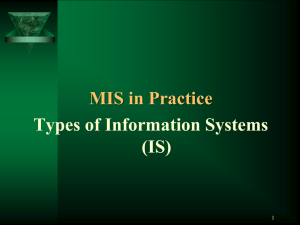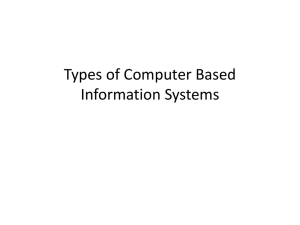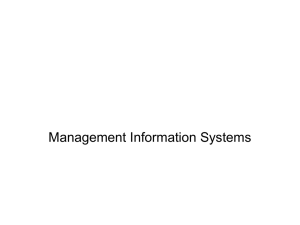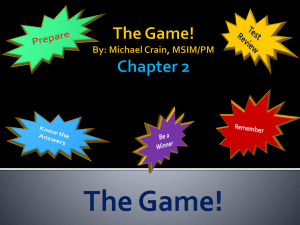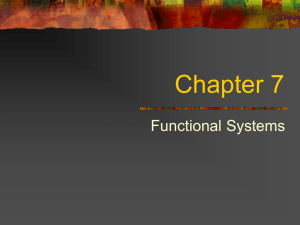Chapter 011 Information Systems
advertisement
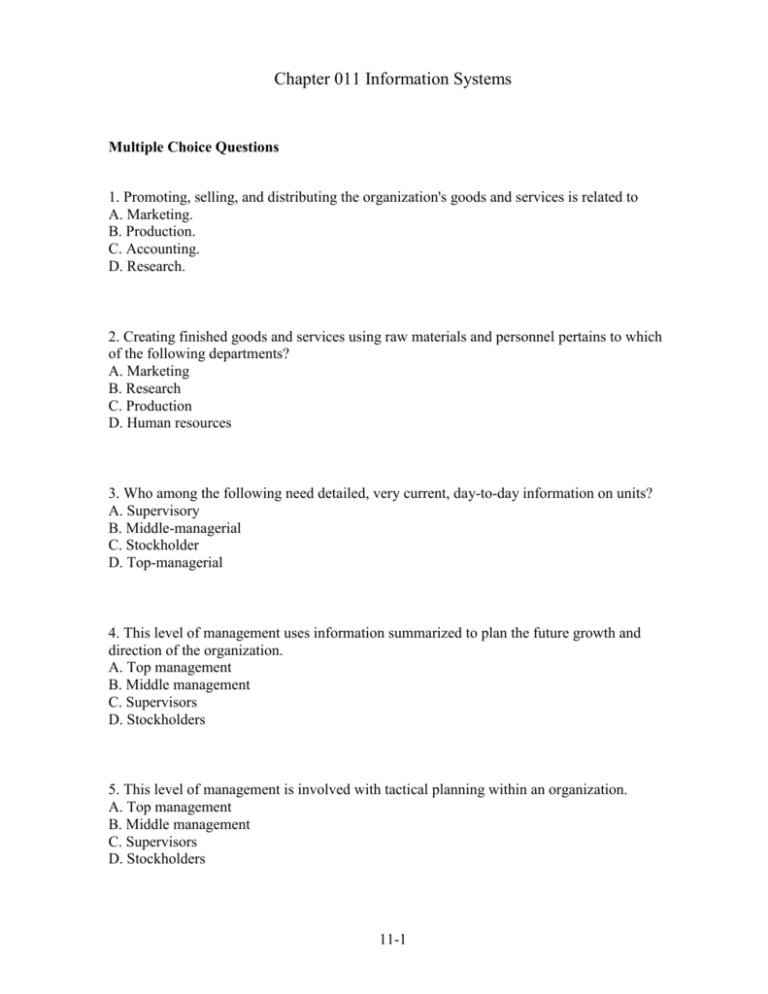
Chapter 011 Information Systems Multiple Choice Questions 1. Promoting, selling, and distributing the organization's goods and services is related to A. Marketing. B. Production. C. Accounting. D. Research. 2. Creating finished goods and services using raw materials and personnel pertains to which of the following departments? A. Marketing B. Research C. Production D. Human resources 3. Who among the following need detailed, very current, day-to-day information on units? A. Supervisory B. Middle-managerial C. Stockholder D. Top-managerial 4. This level of management uses information summarized to plan the future growth and direction of the organization. A. Top management B. Middle management C. Supervisors D. Stockholders 5. This level of management is involved with tactical planning within an organization. A. Top management B. Middle management C. Supervisors D. Stockholders 11-1 Chapter 011 Information Systems 6. _____ system helps supervisors by generating databases that act as the foundation for the other information systems. A. Decision support B. Management information C. Transaction processing D. Executive support 7. Which of the following refers to a system that summarizes the detailed data of the transaction processing systems in standard reports for middle-level managers? A. Data processing system (DPS) B. Management information system (MIS) C. Decision support system (DSS) D. Executive support system (ESS) 8. Management Information Systems are used by A. employee-level workers. B. supervisor-level management. C. middle management. D. top-level management. 9. Which among the following presents information in the most highly summarized form? A. Transaction processing system (TPS) B. Management information system (MIS) C. Decision support system (DSS) D. Executive support system (ESS) 10. A transaction processing system is also sometimes referred to as a A. sales order processing. B. data processing system. C. management information system. D. database management. 11-2 Chapter 011 Information Systems 11. The _____ activity records the customer requests for goods or services. A. payroll B. sales order processing C. inventory D. accounts receivable 12. Money collected from or owed by customers is called A. accounts payable. B. inventory. C. accounts receivable. D. sales order processing. 13. The _____ keeps records of the number of each kind of part or finished good in the warehouse. A. payroll B. inventory control system C. sales order processing D. general ledger 14. _____ show the difference between the income and expenses of the company for a specific time period. A. Income statements B. Balance sheets C. Accounts payable D. Inventory 15. Assets, liabilities, and the equity owned by the owners of an organization is all recorded in the A. balance sheet. B. accounts payable. C. income statement. D. payroll. 11-3 Chapter 011 Information Systems 16. Regional managers can compare their sales reports with that of the others by using A. management reports. B. periodic reports. C. exception reports. D. demand reports. 17. A sales report that shows that certain items are selling significantly above or below marketing department forecasts is an example of this type of report. A. Periodic B. Demand C. Inventory D. Exception 18. This report is used to analyze data and its reports do not have a fixed format. A. Management information system B. Decision support system C. Transaction processing system D. Executive support system 19. In a GDSS, the _____ is generally a decision-maker. A. programmer B. technician C. user D. client 20. This typically consists of transactions from the transaction processing system. A. System software B. External data C. Decision model D. Internal data 11-4 Chapter 011 Information Systems 21. This decision model controls the work of the organization, such as financial planning and sales promotion planning. A. Strategic model B. Corporate model C. Tactical model D. Operational model 22. These systems often can be organized to retrieve information from databases outside the company. A. Transaction processing system (TPS) B. Decision support system (DSS) C. Management information system (MIS) D. Executive support system (ESS) 23. _____ are used in managing documents, communication and scheduling. A. Office automation systems B. Transaction processing systems C. Knowledge work systems D. Executive support systems 24. Project resources can be scheduled, planned and controlled using A. project manager programs. B. operational manager programs. C. knowledge work systems. D. CAD/CAM systems. 25. CAD/CAM would be most useful in what industry? A. Motion picture B. Automobile manufacturing C. Food service D. Retail 11-5 Chapter 011 Information Systems True / False Questions 26. The marketing department identifies, investigates, and develops new products and services. True False 27. Research department identifies, investigates, and develops new products and services. True False 28. The production department strictly involves itself only with the creation and finish of goods that are tangible. True False 29. Supervisors responsibilities include operational matters. True False 30. Middle-level managers are responsible for the planning and the implementation of longterm goals. True False 31. Top-level managers need information both from within the organization and from outside. True False 32. The management information system records day-to-day transactions, such as customer orders, bills, inventory levels, and production output. True False 11-6 Chapter 011 Information Systems 33. The executive support system can analyze the effects of events and trends outside the organization. True False 34. The executive support system helps top-level managers oversee the company's operations and develop strategic plans. True False 35. Accounts payable refers to money the company owes its suppliers for materials and services it has received. True False 36. A purchase order form pertains to the sales order processing department. True False 37. An MIS differs from the transaction processing system in that it creates databases. True False 38. Demand reports need not be produced periodically. True False 39. In case of a union strike, the manager in charge of manufacturing might consult the management information system. True False 11-7 Chapter 011 Information Systems 40. Most DSSs, although traditionally created for large computer systems, are now being used in microcomputers too. True False 41. Consumer profiles, census data, and economic forecasts are examples of external data. True False 42. There are three basic decision models used in a GDSS: operational, strategic, and financial. True False 43. An office automation systems are primarily targeted at assisting multifunctional robots at research facilities. True False 44. Knowledge workers use specialized information systems called KWS to create information in their area of expertise. True False 45. CAD/CAM systems use powerful microcomputers running special programs that integrate the design and manufacturing activities. True False Fill in the Blank Questions 46. Effective operation within any organization requires an efficient and coordinated flow of _____ throughout the organization. ________________________________________ 11-8 Chapter 011 Information Systems 47. The _____ department tracks all sales, purchases, and transfers of funds. ________________________________________ 48. _____ need weekly or monthly reports so as to be able to develop budget projections. ________________________________________ 49. For supervisory managers, information is primarily _____. ________________________________________ 50. Common names for computer-based information systems are transaction processing, management information, _____ support, and executive support systems. ________________________________________ 51. TPS stands for _____. ________________________________________ 52. Every accounting department handles six basic activities. Five of these are sales order processing, accounts receivable, inventory and purchasing, accounts payable, and payroll. All of these are recorded in the _____, the sixth activity. ________________________________________ 53. When an order comes in, the _____ processing activity alerts the warehouse to ship a product. ________________________________________ 54. A typical _____ system can produce income statements and balance sheets. ________________________________________ 11-9 Chapter 011 Information Systems 55. An MIS requires a _____ to integrate summaries from different departments. ________________________________________ 56. Monthly sales and production reports are examples of _____. ________________________________________ 57. A _____ support system is used to support collective work. ________________________________________ 58. A decision support system consists of the user, system software, data, and _____. ________________________________________ 59. The system software is essentially the _____. ________________________________________ 60. _____ models assist top-level managers in long-range planning, such as stating company objectives or planning plant locations. ________________________________________ 61. A(n) _____ support system is primarily designed for someone with little or no spare time, who can obtain essential information without extensive training. ________________________________________ 62. Some _____ support systems provide structured forms to enable managers to streamline their thoughts before sending electronic memos. ________________________________________ 11-10 Chapter 011 Information Systems 63. The fastest growing elements of the information systems are those designed to support _____. ________________________________________ 64. _____ workers are involved with the creation of information (like engineers and scientists). ________________________________________ 65. _____ systems are computer systems that allow people located at various geographic locations to communicate and interact with each other. ________________________________________ Essay Questions 66. What are the five functions of an organization? Briefly explain. 67. Briefly describe the three levels of management. 11-11 Chapter 011 Information Systems 68. Describe the flow of information within an organization and the different levels of information that is required. 69. Name and describe the four most common types of computer-based information systems. 70. Describe in detail the six activities that make up the basis of a typical accounting system. 71. Explain the three common categories of reports that are generated in most organizations. 11-12 Chapter 011 Information Systems 72. Describe the functions and the working of a decision support system. 73. Describe information workers, data workers, and knowledge workers. 74. What are Office Automation Systems? 75. Describe Knowledge Work Systems. How do they work? 11-13 Chapter 011 Information Systems Key Multiple Choice Questions 1. (p. 315) Promoting, selling, and distributing the organization's goods and services is related to A. Marketing. B. Production. C. Accounting. D. Research. Marketing plans, prices, promotes, sells, and distributes the organization's goods and services. Difficulty: Easy 2. (p. 315) Creating finished goods and services using raw materials and personnel pertains to which of the following departments? A. Marketing B. Research C. Production D. Human resources The production department actually creates finished goods and services using raw materials and personnel. Difficulty: Medium 3. (p. 315) Who among the following need detailed, very current, day-to-day information on units? A. Supervisory B. Middle-managerial C. Stockholder D. Top-managerial Supervisors need detailed, very current, day-to-day information on their units so that they can keep operations running smoothly. Difficulty: Easy 11-14 Chapter 011 Information Systems Key 4. (p. 317) This level of management uses information summarized to plan the future growth and direction of the organization. A. Top management B. Middle management C. Supervisors D. Stockholders Top-level managers are concerned with long-range planning (also called strategic planning). They need information that will help them to plan the future growth and direction of the organization. Difficulty: Easy 5. (p. 315) This level of management is involved with tactical planning within an organization. A. Top management B. Middle management C. Supervisors D. Stockholders Middle-level managers deal with control, planning (also called tactical planning), and decision making. They implement the long-term goals of the organization. Difficulty: Medium 6. (p. 319) _____ system helps supervisors by generating databases that act as the foundation for the other information systems. A. Decision support B. Management information C. Transaction processing D. Executive support The transaction processing system (TPS) helps supervisors by generating databases that act as the foundation for the other information systems. Difficulty: Hard 11-15 Chapter 011 Information Systems Key 7. (p. 319) Which of the following refers to a system that summarizes the detailed data of the transaction processing systems in standard reports for middle-level managers? A. Data processing system (DPS) B. Management information system (MIS) C. Decision support system (DSS) D. Executive support system (ESS) Management information system (MIS) summarizes the detailed data of the transaction processing system (TPS) in standard reports for middle-level managers. Difficulty: Medium 8. (p. 319) Management Information Systems are used by A. employee-level workers. B. supervisor-level management. C. middle management. D. top-level management. Management Information Systems (MIS) are used by middle management. Difficulty: Medium 9. (p. 319) Which among the following presents information in the most highly summarized form? A. Transaction processing system (TPS) B. Management information system (MIS) C. Decision support system (DSS) D. Executive support system (ESS) ESS present information in a very highly summarized form. Difficulty: Easy 11-16 Chapter 011 Information Systems Key 10. (p. 320) A transaction processing system is also sometimes referred to as a A. sales order processing. B. data processing system. C. management information system. D. database management. A transaction processing system is also sometimes referred to as a data processing system. Difficulty: Easy 11. (p. 320) The _____ activity records the customer requests for goods or services. A. payroll B. sales order processing C. inventory D. accounts receivable Sales order processing records the customer requests for the company's products or services. Difficulty: Easy 12. (p. 320) Money collected from or owed by customers is called A. accounts payable. B. inventory. C. accounts receivable. D. sales order processing. Accounts receivable records money received from or owed by customers. Difficulty: Medium 11-17 Chapter 011 Information Systems Key 13. (p. 321) The _____ keeps records of the number of each kind of part or finished good in the warehouse. A. payroll B. inventory control system C. sales order processing D. general ledger Inventory control system keeps records of the number of each kind of part or finished good in the warehouse. Difficulty: Medium 14. (p. 321) _____ show the difference between the income and expenses of the company for a specific time period. A. Income statements B. Balance sheets C. Accounts payable D. Inventory Income statements show a company's financial performance–income, expenses, and the difference between them for a specific time period. Difficulty: Medium 15. (p. 321) Assets, liabilities, and the equity owned by the owners of an organization is all recorded in the A. balance sheet. B. accounts payable. C. income statement. D. payroll. Balance sheets list the overall financial condition of an organization. They include assets (for example, buildings and property owned), liabilities (debts), and how much of the organization (the equity) is owned by the owners. Difficulty: Medium 11-18 Chapter 011 Information Systems Key 16. (p. 322) Regional managers can compare their sales reports with that of the others by using A. management reports. B. periodic reports. C. exception reports. D. demand reports. Periodic reports are produced at regular intervals–weekly, monthly, or quarterly. For comparison purposes, a regional manager is also able to see the sales reports of other regional managers. Difficulty: Hard 17. (p. 322) A sales report that shows that certain items are selling significantly above or below marketing department forecasts is an example of this type of report. A. Periodic B. Demand C. Inventory D. Exception Exception reports call attention to unusual events. An example is a sales report that shows that certain items are selling significantly above or below marketing department forecasts. Difficulty: Medium 18. (p. 323) This report is used to analyze data and its reports do not have a fixed format. A. Management information system B. Decision support system C. Transaction processing system D. Executive support system A DSS is used to analyze data. Moreover, it produces reports that do not have a fixed format. Difficulty: Medium 11-19 Chapter 011 Information Systems Key 19. (p. 323) In a GDSS, the _____ is generally a decision-maker. A. programmer B. technician C. user D. client The user is someone who has to make decisions – a manager, often a middle-level manager. Difficulty: Medium 20. (p. 323) This typically consists of transactions from the transaction processing system. A. System software B. External data C. Decision model D. Internal data Internal data in the DSS is the data from within the organization–consists principally of transactions from the transaction processing system. Difficulty: Hard 21. (p. 323) This decision model controls the work of the organization, such as financial planning and sales promotion planning. A. Strategic model B. Corporate model C. Tactical model D. Operational model Tactical models are concerned with helping middle-managers who control the work of the organization, such as financial planning and sales promotion planning. Difficulty: Medium 11-20 Chapter 011 Information Systems Key 22. (p. 324) These systems often can be organized to retrieve information from databases outside the company. A. Transaction processing system (TPS) B. Decision support system (DSS) C. Management information system (MIS) D. Executive support system (ESS) ESS may be organized to retrieve information from databases outside the company, such as business-news services. This enables a firm to watch for stories on competitors and stay current on relevant news events that could affect its business. Difficulty: Hard 23. (p. 325) _____ are used in managing documents, communication and scheduling. A. Office automation systems B. Transaction processing systems C. Knowledge work systems D. Executive support systems OAS focus on managing documents, communication, and scheduling. Difficulty: Medium 24. (p. 325) Project resources can be scheduled, planned and controlled using A. project manager programs. B. operational manager programs. C. knowledge work systems. D. CAD/CAM systems. Project managers are programs designed to schedule, plan, and control project resources. Difficulty: Medium 11-21 Chapter 011 Information Systems Key 25. (p. 326) CAD/CAM would be most useful in what industry? A. Motion picture B. Automobile manufacturing C. Food service D. Retail CAD/CAM would be most useful in the automobile manufacturing industry. Difficulty: Easy True / False Questions 26. (p. 315) The marketing department identifies, investigates, and develops new products and services. FALSE Difficulty: Easy 27. (p. 315) Research department identifies, investigates, and develops new products and services. TRUE Difficulty: Easy 28. (p. 315) The production department strictly involves itself only with the creation and finish of goods that are tangible. FALSE Difficulty: Medium 11-22 Chapter 011 Information Systems Key 29. (p. 315) Supervisors responsibilities include operational matters. TRUE Difficulty: Easy 30. (p. 315) Middle-level managers are responsible for the planning and the implementation of long-term goals. FALSE Difficulty: Medium 31. (p. 317) Top-level managers need information both from within the organization and from outside. TRUE Difficulty: Easy 32. (p. 319) The management information system records day-to-day transactions, such as customer orders, bills, inventory levels, and production output. FALSE Difficulty: Medium 33. (p. 319) The executive support system can analyze the effects of events and trends outside the organization. FALSE Difficulty: Hard 11-23 Chapter 011 Information Systems Key 34. (p. 319) The executive support system helps top-level managers oversee the company's operations and develop strategic plans. TRUE Difficulty: Easy 35. (p. 321) Accounts payable refers to money the company owes its suppliers for materials and services it has received. TRUE Difficulty: Easy 36. (p. 321) A purchase order form pertains to the sales order processing department. FALSE Difficulty: Medium 37. (p. 322) An MIS differs from the transaction processing system in that it creates databases. FALSE Difficulty: Hard 38. (p. 322) Demand reports need not be produced periodically. TRUE Difficulty: Medium 39. (p. 322) In case of a union strike, the manager in charge of manufacturing might consult the management information system. FALSE Difficulty: Medium 11-24 Chapter 011 Information Systems Key 40. (p. 323) Most DSSs, although traditionally created for large computer systems, are now being used in microcomputers too. TRUE Difficulty: Hard 41. (p. 323) Consumer profiles, census data, and economic forecasts are examples of external data. TRUE Difficulty: Easy 42. (p. 323) There are three basic decision models used in a GDSS: operational, strategic, and financial. FALSE Difficulty: Medium 43. (p. 325) An office automation systems are primarily targeted at assisting multifunctional robots at research facilities. FALSE Difficulty: Easy 44. (p. 326) Knowledge workers use specialized information systems called KWS to create information in their area of expertise. TRUE Difficulty: Medium 11-25 Chapter 011 Information Systems Key 45. (p. 326) CAD/CAM systems use powerful microcomputers running special programs that integrate the design and manufacturing activities. TRUE Difficulty: Medium Fill in the Blank Questions 46. (p. 314) Effective operation within any organization requires an efficient and coordinated flow of _____ throughout the organization. information Effective operations require an efficient and coordinated flow of information throughout the organization. Difficulty: Easy 47. (p. 315) The _____ department tracks all sales, purchases, and transfers of funds. accounting The accounting department tracks all sales, payments, and transfers of funds. Difficulty: Easy 48. (p. 315) _____ need weekly or monthly reports so as to be able to develop budget projections. Middle-level managers or middle management Middle-level managers deal with control, planning (also called tactical planning), and decision making. Difficulty: Medium 11-26 Chapter 011 Information Systems Key 49. (p. 318) For supervisory managers, information is primarily _____. vertical For supervisory managers, information flow is primarily vertical. That is, supervisors communicate mainly with their middle managers and with the workers beneath them. Difficulty: Easy 50. (p. 319) Common names for computer-based information systems are transaction processing, management information, _____ support, and executive support systems. decision Although different organizations may use different names, the most common names are transaction processing, management information, decision support, and executive support systems. Difficulty: Medium 51. (p. 319) TPS stands for _____. transaction processing system The transaction processing system (TPS) records day-to-day transactions, such as customer orders, bills, inventory levels, and production output. Difficulty: Easy 52. (p. 321) Every accounting department handles six basic activities. Five of these are sales order processing, accounts receivable, inventory and purchasing, accounts payable, and payroll. All of these are recorded in the _____, the sixth activity. general ledger The general ledger keeps track of summaries of all of the other accounting activities. Difficulty: Medium 11-27 Chapter 011 Information Systems Key 53. (p. 320) When an order comes in, the _____ processing activity alerts the warehouse to ship a product. sales order The sales order processing activity records the customer requests for the company's products or services. Difficulty: Hard 54. (p. 321) A typical _____ system can produce income statements and balance sheets. general ledger The general ledger keeps track of all summaries of all the accounting transactions. A typical general ledger system can produce income statements and balance sheets. Difficulty: Medium 55. (p. 322) An MIS requires a _____ to integrate summaries from different departments. database management system or DBMS An MIS can draw from the databases of several departments. Thus, an MIS requires a database management system that integrates the databases of the different departments. Difficulty: Hard 56. (p. 322) Monthly sales and production reports are examples of _____. periodic reports Periodic reports are produced at regular intervals–weekly, monthly, or quarterly, for instance. Examples are a company's monthly sales and production reports. Difficulty: Medium 11-28 Chapter 011 Information Systems Key 57. (p. 323) A _____ support system is used to support collective work. group decision Frequently, a team is formed to address large problems. A group decision support system (GDSS) is then used to support this collective work. Difficulty: Medium 58. (p. 323) A decision support system consists of the user, system software, data, and _____. decision models Essentially, a decision support system consists of four parts: the user, system software, data, and decision models. Difficulty: Medium 59. (p. 323) The system software is essentially the _____. operating system System software is essentially the operating system – programs designed to work behind the scenes to handle detailed operating procedures. Difficulty: Hard 60. (p. 323) _____ models assist top-level managers in long-range planning, such as stating company objectives or planning plant locations. Strategic Strategic models assist top-level managers in long-range planning, such as stating company objectives or planning plant locations. Difficulty: Medium 11-29 Chapter 011 Information Systems Key 61. (p. 324) A(n) _____ support system is primarily designed for someone with little or no spare time, who can obtain essential information without extensive training. executive An executive support system (ESS) is specifically designed to be easy to use. This is so that a top executive with little spare time, for example, can obtain essential information without extensive training. Difficulty: Easy 62. (p. 325) Some _____ support systems provide structured forms to enable managers to streamline their thoughts before sending electronic memos. executive Executive support systems (ESSs) permit a firm's top executives to gain direct access to information about the company's performance. Difficulty: Hard 63. (p. 325) The fastest growing elements of the information systems are those designed to support _____. information workers There are many other information systems to support different individuals and functions. The fastest-growing are information systems designed to support information workers. Difficulty: Hard 11-30 Chapter 011 Information Systems Key 64. (p. 325) _____ workers are involved with the creation of information (like engineers and scientists). Knowledge Data workers are involved with distribution and communication of information (like secretaries and clerks), while knowledge workers are involved with the creation of information (like engineers and scientists). Difficulty: Medium 65. (p. 326) _____ systems are computer systems that allow people located at various geographic locations to communicate and interact with each other. Videoconferencing Videoconferencing systems are computer systems that allow people located at various geographic locations to communicate and have in-person meetings. Difficulty: Easy Essay Questions 66. (p. 315) What are the five functions of an organization? Briefly explain. The five functions (or departments) of an organization are: accounting, marketing, research, production, and human resources. Accounting records all financial activity from billing customers to paying employees. It also produces reports detailing the financial condition of the company. Marketing plans, prices, promotes, sells, and distributes the organization's goods and services. Human resources focus on people–hiring, training, promoting, and any number of other human-centered activities within the organization. This function relates to people in each of the functional areas, including accountants, sales representatives, human resource specialists, production workers, and research scientists. Production actually creates finished goods and services using raw materials and personnel. Research identifies, investigates, and develops new products and services. Difficulty: Medium 11-31 Chapter 011 Information Systems Key 67. (p. 315) Briefly describe the three levels of management. The three levels of management are the following: Supervisors: who manage and monitor the employees or workers–those who actually produce the goods and services. Thus, these managers have responsibility relating to operational matters. They monitor day-to-day events and immediately take corrective action, if necessary. Middle management: these managers deal with control, planning (also called tactical planning), and decision making. They implement the long-term goals of the organization. Top management: these managers are concerned with long-range planning (also called strategic planning). They need information that will help them to plan the future growth and direction of the organization. Difficulty: Medium 68. (p. 316, 317) Describe the flow of information within an organization and the different levels of information that is required. Each level of management has different information needs. Top-level managers need information that is summarized in capsule form to reveal the overall condition of the business. They also need information from outside the organization, because top-level managers need to forecast and plan for long-range events. Middle-level managers need summarized information–weekly or monthly reports. They need to develop budget projections and to evaluate the performance of supervisors. Supervisors need detailed, very current, day-to-day information on their units so that they can keep operations running smoothly. For top-level managers, the flow of information from within the organization is both vertical and horizontal. The top-level managers, such as the chief executive officer (CEO), need information from below and from all departments. They also need information from outside the organization. For middle-level managers, the information flow is both vertical and horizontal across functional lines within the organization. For supervisory managers, information flow is primarily vertical. That is, supervisors communicate mainly with their middle managers and with the workers beneath them. Difficulty: Hard 11-32 Chapter 011 Information Systems Key 69. (p. 319) Name and describe the four most common types of computer-based information systems. Transaction processing systems (TPS) record the day-to-day transactions and build the base databases for the other systems. Management information systems (MIS) summarize the TPS output in standard reports for middle-level managers. Decision support systems (DSS) assist middle managers in making decisions by analyzing various scenarios. Executive support systems (ESS) provide easy-to-use overviews of an entire organization, in a highly summarized form. Difficulty: Medium 70. (p. 320, 321) Describe in detail the six activities that make up the basis of a typical accounting system. The six basic accounting functions include sales order processing, accounts receivables, inventory and purchasing, accounts payable, payroll, and general ledger activities. The sales order processing activity records the customer requests for the company's products or services, and the request is in turn processed to the warehousing department. The accounts receivable activity records money received from or owed by customers. Inventory consists of the parts and finished goods that the company has in stock. An inventory control system keeps records of the number of each kind of part or finished good in the warehouse. Purchasing is the buying of materials and services. Often a purchase order is used. Accounts payable refers to money the company owes its suppliers for materials and services it has received. The payroll activity is concerned with calculating employee paychecks. Paychecks may be calculated from employee time cards or, in some cases, supervisors' time sheets. The general ledger keeps track of all summaries of all the foregoing transactions. A typical general ledger system can produce income statements and balance sheets. Difficulty: Hard 11-33 Chapter 011 Information Systems Key 71. (p. 322) Explain the three common categories of reports that are generated in most organizations. Periodic reports are produced at regular intervals–weekly, monthly, or quarterly, for instance. Exception reports call attention to unusual events. An example is a sales report that shows that certain items are selling significantly above or below marketing department forecasts. The opposite of a periodic report, a demand report, is produced on request. Such a report is not needed periodically, but it may be required when requested by the U.S. government. Difficulty: Easy 72. (p. 323) Describe the functions and the working of a decision support system. A decision support system (DSS) enables managers to get answers to unexpected and generally nonrecurring kinds of problems. Frequently, a team is formed to address large problems. A group decision support system (GDSS) is then used to support this collective work. A DSS, is quite different from a transaction processing system, which simply records data. It is also different from a management information system, which summarizes data in predetermined reports. A DSS is used to analyze data. Moreover, it produces reports that do not have a fixed format. This makes the DSS a flexible tool for analysis. At one time, most DSSs were designed for large computer systems. Now, microcomputers, with their increased power and sophisticated software, such as spreadsheet and database programs, are widely used for DSS. Users of a DSS are managers, not computer programmers. Thus, a DSS must be easy to use–or most likely it will not be used at all. Essentially, it consists of four parts: the user, system software, data, and decision models. Difficulty: Hard 73. (p. 325) Describe information workers, data workers, and knowledge workers. Information workers distribute, communicate, and create information. They are the organization's secretaries, clerks, engineers, and scientists, to name a few. Some are involved with distribution and communication of information (like the secretaries and clerks). They are called data workers. Others are involved with the creation of information (like the engineers and scientists). They are called knowledge workers. Difficulty: Medium 11-34 Chapter 011 Information Systems Key 74. (p. 325) What are Office Automation Systems? Office automation systems (OASs) are support systems designed primarily to support data workers. These systems focus on managing documents, communicating, and scheduling. Documents are managed using word processing, Web authoring, desktop publishing, and other image technologies. Project managers are programs designed to schedule, plan, and control project resources. Microsoft Project is the most widely used project manager. Videoconferencing systems are computer systems that allow people located at various geographic locations to communicate and have in-person meetings. Difficulty: Easy 75. (p. 326) Describe Knowledge Work Systems. How do they work? Knowledge workers use office automation systems (OASs). Additionally, they use specialized information systems called knowledge work systems (KWSs) to create information in their areas of expertise. For example, engineers involved in product design and manufacturing use computer-aided design/computer-aided manufacturing (CAD/CAM) systems. These KWSs consist of powerful micro-computers running special programs that integrate the design and manufacturing activities. CAD/CAM is widely used in the manufacture of automobiles and other products. Difficulty: Medium 11-35
